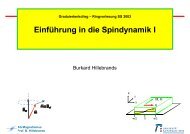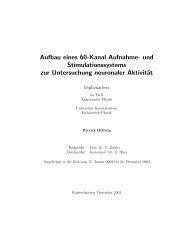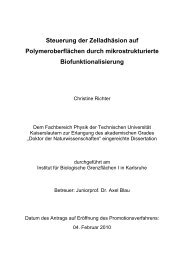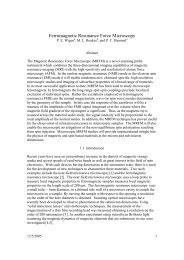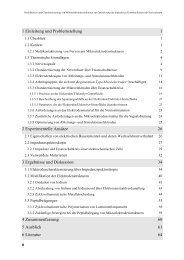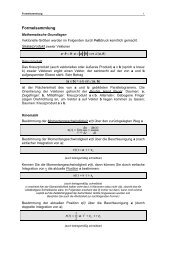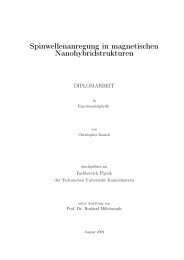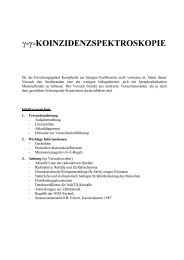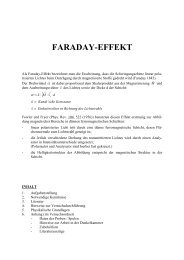Optical near-field interference in the excitation of a bowtie ...
Optical near-field interference in the excitation of a bowtie ...
Optical near-field interference in the excitation of a bowtie ...
You also want an ePaper? Increase the reach of your titles
YUMPU automatically turns print PDFs into web optimized ePapers that Google loves.
P. MELCHIOR et al. PHYSICAL REVIEW B 83, 235407 (2011)<br />
Relative Field Amplitude<br />
2.5<br />
2.0<br />
1.5<br />
1.0<br />
0.5<br />
700 750 800 850 900 950 1000<br />
Wavelength [nm]<br />
upper corner<br />
lower corner<br />
gap<br />
corner TM z-comp<br />
corner TE z-comp<br />
gap TM<br />
Laser spectrum<br />
FIG. 3. (Color onl<strong>in</strong>e) Simulated <strong>near</strong>-<strong>field</strong> response (z component)<br />
recorded at a s<strong>in</strong>gle corner <strong>of</strong> <strong>the</strong> left nanoprism for TE (red<br />
dashed l<strong>in</strong>e) and TM (black dash dotted l<strong>in</strong>e) polarized <strong>excitation</strong> <strong>of</strong><br />
a <strong>bowtie</strong> nanoantenna. The blue dotted l<strong>in</strong>e shows <strong>the</strong> response at<br />
<strong>the</strong> gap corner <strong>of</strong> <strong>the</strong> right nanoprism. The shadowed area shows <strong>the</strong><br />
bandwidth (FWHM) <strong>of</strong> <strong>the</strong> laser pulses used with a maximum at λ =<br />
795 nm (yellow solid l<strong>in</strong>e). The <strong>in</strong>set sketches <strong>the</strong> po<strong>in</strong>ts <strong>of</strong> <strong>in</strong>terest.<br />
<strong>in</strong>side <strong>the</strong> metal as only <strong>the</strong> <strong>in</strong>ternal <strong>field</strong> is relevant for <strong>the</strong><br />
photo<strong>excitation</strong> <strong>in</strong>to <strong>in</strong>termediate bound states and thus also<br />
dom<strong>in</strong>ates <strong>the</strong> multiphoton photoemission process. We focus<br />
our <strong>in</strong>vestigation <strong>in</strong> this work on <strong>the</strong> <strong>near</strong>-<strong>field</strong> <strong><strong>in</strong>terference</strong><br />
and show <strong>the</strong>refore <strong>in</strong> Fig. 3 <strong>the</strong> local response only at <strong>the</strong><br />
outer corner <strong>of</strong> <strong>the</strong> <strong>bowtie</strong> structure where we present <strong>the</strong><br />
<strong><strong>in</strong>terference</strong> effect later on.<br />
The local <strong>field</strong> components Eloc,i α (r,ω), with α ∈ {x,y,z},<br />
as derived from <strong>the</strong> FIM calculations for TM- and TE-polarized<br />
illum<strong>in</strong>ation are composed like <strong>in</strong> Eq. (3) to simulate a<br />
simultaneous <strong>excitation</strong> with TM and TE polarization. The<br />
<strong>in</strong>fluence <strong>of</strong> <strong>the</strong> <strong><strong>in</strong>terference</strong> term [<strong>the</strong> term on <strong>the</strong> right-hand<br />
side <strong>of</strong> Eq. (1)] is <strong>in</strong>vestigated by a variation <strong>of</strong> <strong>the</strong> phase<br />
difference between <strong>the</strong> two <strong>in</strong>dependent <strong>excitation</strong> <strong>field</strong>s, as<br />
will be discussed <strong>in</strong> detail <strong>in</strong> Sec. IV C.<br />
IV. RESULTS AND DISCUSSION<br />
A. Near-<strong>field</strong> modes: Experiments<br />
Apply<strong>in</strong>g a femtosecond laser pulse to <strong>the</strong> nanostructure<br />
as shown <strong>in</strong> Fig. 2 with a photon energy <strong>of</strong> hν = 1.55 eV, a<br />
hot-spot-like photoemission pattern is observed [see Figs. 4(b)<br />
and 4(c)]. The emission pattern no longer follows <strong>the</strong> shape<br />
<strong>of</strong> <strong>the</strong> nanoantenna but is now localized <strong>in</strong> dist<strong>in</strong>ct regions<br />
<strong>of</strong> <strong>the</strong> structure depend<strong>in</strong>g on <strong>the</strong> polarization state <strong>of</strong> <strong>the</strong><br />
<strong>in</strong>cident light. Note that <strong>the</strong> comparison with 1PPE images<br />
[see Fig. 4(a)] obta<strong>in</strong>ed under UV <strong>excitation</strong> and <strong>the</strong> identical<br />
sett<strong>in</strong>gs <strong>of</strong> <strong>the</strong> PEEM apparatus allows determ<strong>in</strong><strong>in</strong>g <strong>the</strong><br />
exact position <strong>of</strong> <strong>the</strong> hot-spot photoemission on <strong>the</strong> structure<br />
(outl<strong>in</strong>es <strong>in</strong> Fig. 4).<br />
For TM-polarized <strong>excitation</strong> an emission maximum <strong>in</strong> <strong>the</strong><br />
gap region is clearly resolved [Fig. 4(b)]. The unambiguously<br />
located nanostructure outl<strong>in</strong>e <strong>in</strong> this emission pattern shows<br />
that <strong>the</strong> emission maximum is centered at <strong>the</strong> tip <strong>of</strong> <strong>the</strong><br />
right nanoprism ra<strong>the</strong>r than <strong>in</strong> <strong>the</strong> middle <strong>of</strong> <strong>the</strong> gap. In<br />
(a)<br />
(b)<br />
(c)<br />
350 nm<br />
TM<br />
k ||<br />
TE<br />
k ||<br />
>200<br />
160<br />
120<br />
80<br />
40<br />
20<br />
0<br />
>130<br />
120<br />
100<br />
80<br />
60<br />
40<br />
20<br />
0<br />
>130<br />
120<br />
100<br />
80<br />
60<br />
40<br />
20<br />
0<br />
FIG. 4. Photoemission pattern from <strong>the</strong> <strong>bowtie</strong> antenna. (a) 1PPE<br />
pattern (<strong>of</strong>f-resonant) obta<strong>in</strong>ed under UV <strong>excitation</strong> us<strong>in</strong>g a mercury<br />
lamp. (b) 3PPE pattern under TM-polarized laser pulse <strong>excitation</strong><br />
reveals strong photoemission from <strong>the</strong> antenna gap and a weak<br />
photoemission at <strong>the</strong> corners <strong>of</strong> <strong>the</strong> left nanoprism. (c) 3PPE pattern<br />
under TE-polarized laser pulse <strong>excitation</strong> shows weak photoemission<br />
from <strong>the</strong> corners <strong>of</strong> <strong>the</strong> left nanoprism. The laser beam comes from<br />
<strong>the</strong> right side and is <strong>in</strong>dicated by <strong>the</strong> parallel k vector component k ‖ .<br />
addition to this strong “gap emission” <strong>in</strong> Fig. 4(b), smaller<br />
emission maxima appear at <strong>the</strong> outer corners <strong>of</strong> <strong>the</strong> triangular<br />
nanoprisms. Interest<strong>in</strong>gly, <strong>the</strong>se weak photoemission maxima<br />
appear at <strong>the</strong> left nanoprism only. This asymmetry is attributed<br />
to <strong>the</strong> non-normal illum<strong>in</strong>ation condition, i.e., <strong>the</strong> parallel<br />
component k ‖ <strong>of</strong> <strong>the</strong> <strong>in</strong>cident light is directed toward <strong>the</strong> left.<br />
Due to <strong>the</strong> non-normal <strong>in</strong>cidence <strong>of</strong> <strong>the</strong> light and <strong>the</strong> size <strong>of</strong><br />
<strong>the</strong> structure, which is <strong>in</strong> <strong>the</strong> order <strong>of</strong> one wavelength <strong>of</strong> <strong>the</strong><br />
light, <strong>the</strong> response <strong>of</strong> <strong>the</strong> nanostructure is <strong>in</strong>fluenced by <strong>the</strong><br />
retardation effect.<br />
Under TE <strong>excitation</strong> [Fig. 4(c)] <strong>the</strong> emission pattern <strong>of</strong><br />
<strong>the</strong> nanoantenna changes significantly. The gap area <strong>of</strong> <strong>the</strong><br />
<strong>bowtie</strong> structure exhibits no emission. Only <strong>the</strong> upper and<br />
lower corners <strong>of</strong> <strong>the</strong> left triangular nanoprism appear to be<br />
weakly pronounced. The yield at <strong>the</strong> corners <strong>of</strong> <strong>the</strong> left<br />
nanoprism is under TE <strong>excitation</strong> with <strong>the</strong> same laser <strong>in</strong>tensity<br />
about ten times weaker than for TM <strong>excitation</strong>. The <strong>in</strong>tensity<br />
dependence <strong>of</strong> <strong>the</strong> total photoemission yield <strong>in</strong>dicates that at<br />
least a three-photon process is responsible for <strong>the</strong> detected<br />
emission, i.e., <strong>the</strong> yield scales with <strong>the</strong> sixth power <strong>of</strong> <strong>the</strong><br />
electric <strong>field</strong>. Therefore, <strong>the</strong> electric <strong>field</strong>s at <strong>the</strong> corners <strong>of</strong> <strong>the</strong><br />
left nanoprisms are still <strong>of</strong> <strong>the</strong> same magnitude, although we<br />
observe a strong difference <strong>in</strong> <strong>the</strong> photoemission signal.<br />
235407-4






